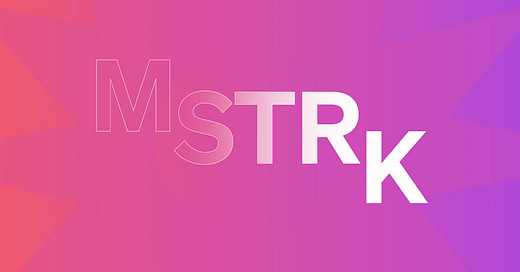On STRK, MicroStrategy's Preferred Equity
MicroStrategy’s unorthodox capital strategy now includes preferred equity: $STRK. It’s a bold play for the holy grail: to harness $MSTR volatility w/o dilution.
Microstrategy’s preferred equity, STRK, might be one of the most compelling securities in the market. Here’s why. But is it good for MSTR itself? That’s a conclusion you will have to reach on your own after reading this.
Usually, preferred equity is the armpit of the capital structure; it is neither volatile like equities, nor does it afford any protection like credit–a classic midcurve asset. But STRK is different– why?
It pays a fixed yield, with essentially no callability features from the issuer. In other words, the [8%] yield is truly perpetual, barring default risk of course. Most preferred comes with a call option that limits upside if rates drop. This means that if you believe rates might go lower (Hint: it will), the dv01 on this instrument is massive - the perpetual 8% PV that is discounted from 4.5% to 2% is a 2x bagger. The double whammy effect is that the probability of default is likely to decrease as well, which will compound the gains even more (as the “probability-weighted Px at 0” decreases).
The reason it does not have a callability feature then is that it actually has a convertibility option, as each pref can be converted to 1/10th of MSTR at $1000. However, this does not mean the strike is $1000 because these are not actually strike-based market conversion ratios (more on that later).
The coupon can be paid in-kind with MSTR. This affords a great degree of flexibility for the issuer to navigate cash management, while also permitting a new mechanism to distribute new shares of MSTR without directly hitting the market. Although unlikely in practice, this means pref investors can actually accumulate MSTR shares without friction.
In essence, STRK is a great instrument because it is super short rates, which in turn has the second order effect of reducing the probability of default, introducing a positive interaction coefficient that can help the instrument appreciate massively– while also theoretically earning MSTR stocks on the side. The combination creates a “reverse covered call” dynamic, i.e. instead of selling MSTR while taking the price risk, you are acquiring MSTR with little price risk.
But is this good for MSTR? That is the million dollar question. And here is why the convertibility option is more exotic than originally meets the eyes. Imagine STRK rises to $200/share due to declining rates (yay!) while MSTR rises to $1200. As a pref investor, you might think you are technically “ITM” to exercise, but economically you are “OTM” since your MV shares are worth $200, instead of 1/10th of MSTR at $120 (boo!). In other words, your new “real” strike just shifted to $2000. This is the Faustian bargain made and why it is impossible for the issuer to have been given call rights. So what does this all mean?
Options traders can’t accurately know the gamma pins because unlike converts which have fixed conversion strikes, the prefs practically have “floating” conversion strikes based on the pref valuation itself. This is most likely an options market and volatility muter, opposite to the converts.
This means STRK’s being short rates is actually also long Ddelta/Drates (i.e. delta decreases as rates go down), as the call becomes economically further OTM. But perversely, when rates go up and STRK hypothetically sinks to $50, the legal strike didn’t move to $500, it’s still at $1000 so you are still out of the money. It is the ultimate “wily chase” of an elusive strike that indeterminately moves against you when you want it the most. This is short volatility.
By now, you will hopefully then have intuited the most important dynamic, which is that the call option STRK has on MSTR is one sided ie. STRK benefits if MSTR rises in value, but MSTR does not explicitly benefit if STRK rises in value*. But in return, this also means STRK’s principal success doesn’t require MSTR’s dilution. Whereas the converts and equity were aligned directionally as the reflexivity built off each other via dilution, STRK has the opposite dampening effect.
This is why STRK itself is a near-perfect instrument. It gives you two chances to win: 1) when rates go down, it’s a huge boon to the principal PV, and 2) if MSTR goes up first, then you have a deep ITM option to convert and own the higher vol asset or just directly sell. Historically I have said the MSTR is a great instrument because it is hypothetically long global carry and short global carry at the same time. $STRK is the most explicit expression of that thesis yet as the next-gen investment vehicle. By absorbing rates volatility to shift MSTR’s volatility, STRK ATMs can fuel MSTR’s rise on the back end, for the first time–without any dilution. This was of course always the holy grail of MSTR. The open question is: can MSTR survive its path towards the terminal state with lower volatility?




STRK today so far: low $79.40 now $85.00!